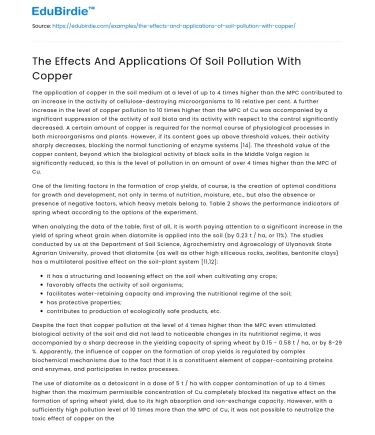The application of copper in the soil medium at a level of up to 4 times higher than the MPC contributed to an increase in the activity of cellulose-destroying microorganisms to 16 relative per cent. A further increase in the level of copper pollution to 10 times higher than the MPC of Cu was accompanied by a significant suppression of the activity of soil biota and its activity with respect to the control significantly decreased. A certain amount of copper is required for the normal course of physiological processes in both microorganisms and plants. However, if its content goes up above threshold values, their activity sharply decreases, blocking the normal functioning of enzyme systems [14]. The threshold value of the copper content, beyond which the biological activity of black soils in the Middle Volga region is significantly reduced, so this is the level of pollution in an amount of over 4 times higher than the MPC of Cu.
One of the limiting factors in the formation of crop yields, of course, is the creation of optimal conditions for growth and development, not only in terms of nutrition, moisture, etc., but also the absence or presence of negative factors, which heavy metals belong to. Table 2 shows the performance indicators of spring wheat according to the options of the experiment.
Save your time!
We can take care of your essay
- Proper editing and formatting
- Free revision, title page, and bibliography
- Flexible prices and money-back guarantee
When analyzing the data of the table, first of all, it is worth paying attention to a significant increase in the yield of spring wheat grain when diatomite is applied into the soil (by 0.23 t / ha, or 11%). The studies conducted by us at the Department of Soil Science, Agrochemistry and Agroecology of Ulyanovsk State Agrarian University, proved that diatomite (as well as other high siliceous rocks, zeolites, bentonite clays) has a multilateral positive effect on the soil-plant system [11,12]:
- it has a structuring and loosening effect on the soil when cultivating any crops;
- favorably affects the activity of soil organisms;
- facilitates water-retaining capacity and improving the nutritional regime of the soil;
- has protective properties;
- contributes to production of ecologically safe products, etc.
Despite the fact that copper pollution at the level of 4 times higher than the MPC even stimulated biological activity of the soil and did not lead to noticeable changes in its nutritional regime, it was accompanied by a sharp decrease in the yielding capacity of spring wheat by 0.15 - 0.58 t / ha, or by 8-29 %. Apparently, the influence of copper on the formation of crop yields is regulated by complex biochemical mechanisms due to the fact that it is a constituent element of copper-containing proteins and enzymes, and participates in redox processes.
The use of diatomite as a detoxicant in a dose of 5 t / ha with copper contamination of up to 4 times higher than the maximum permissible concentration of Cu completely blocked its negative effect on the formation of spring wheat yield, due to its high absorption and ion-exchange capacity. However, with a sufficiently high pollution level of 10 times more than the MPC of Cu, it was not possible to neutralize the toxic effect of copper on the formation of crop yield and it decreased by 0.22 t / ha.
Thus, soil pollution with copper even in the amount of 2 times more than the MPC of Cu was accompanied by a loss of spring wheat yield by 0.15 t / ha. With a higher level of pollution (up to 10 times higher than the MPC), crop losses can reach 0.58 t / ha (almost a third, 29%). Diatomite as a detoxicant contributes not only to the spring wheat yield increase, due to its beneficial effect on soil properties and optimization of soil conditions for plant growth, but also to obtaining ecologically safe products.






 Stuck on your essay?
Stuck on your essay?

